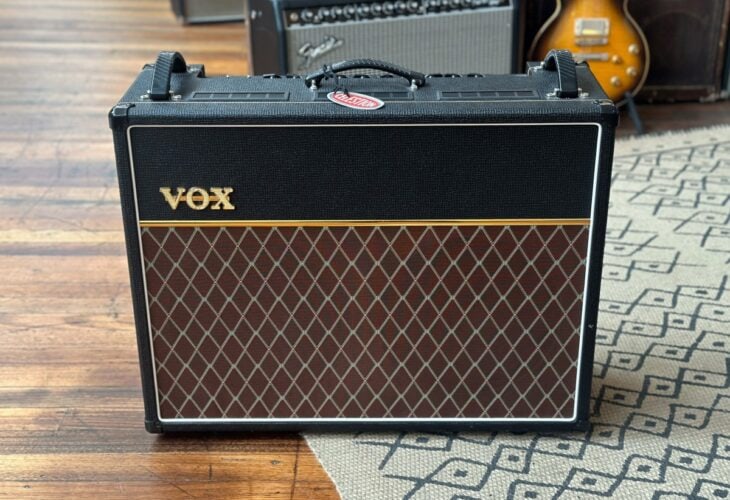How did a band that just wanted to bring punk to the stage end up being the cornerstone of the post-punk movement? With only two records, Joy Division was able to shift the musical paradigm, opening the road for many bands that today are worldwide famous.
Although the band came to an abrupt ending after Ian Curtis’ suicide, their legacy of dark sounds, catchy melodies, and obscure, atmospheric echoes still lives today.
I spent a lot of time playing post-punk and I surfed deep in Joy Division records to achieve their sound. This is what I came out with. So, if you’re a post-punk lover, this post is for you.
Table of Contents
Joy Division Guitars

Guitar duties in Joy Division were divided into two players: Bernard Sumner and Ian Curtis. Ian was also the singer, and according to bandmates and fans, kind of reluctant to pick up the guitar for live performances.
Indeed, you must have seen countless photos and videos of a skinny, pale Ian dancing manically with no guitar.
But before we dive into the instruments, let me tell you a bit about the role of the guitar in the band. Joy Division was no ordinary punk act from the late ‘70s. No, it was much more innovative than that. The guitar in Joy Division plays a much more rhythmic role than in other bands. Moreover, it’s like the role of the guitar and the bass are inverted.
We all know Peter Hook is one of the best melodic bass players on the face of Earth. He did it with Joy Division and, later, with New Order.
But what instruments were fueling this band’s dark, post-punk forces forward?
Bernard Sumner played a very odd guitar called the Shergold Masquerader. The company and the guitar had disappeared after the roaring eighties but made a stellar comeback in 2017. They recruited British luthier James Eggle and re-designed the whole lineup with different takes on the same concept.
You can contact Shergold for a Masquerader, designed in England, and built in China and Indonesia.
You can see the original in this early live video. It’s a double-cut guitar with a maple neck, dual humbuckers, and a whammy bar.
The closest you can get to that guitar, in my opinion, is with a Music Man StingRay guitar. If that price tag is a little too hefty, then a Sterling by Music Man StingRay SR50 might be a better choice.

Ian Curtis, on the other hand, played a truly one-of-a-kind instrument, a VOX Phantom VI (recently auctioned for £162,562.50). This guitar featured a myriad of built-in effects and was uniquely shaped. It featured 3 single-coil pickups, a Bigsby vibrato, and a rosewood fingerboard.
Although it’s discontinued, the Phantom Guitar Company still makes a version of them. Otherwise, you can obtain that tone (sans the effects) with a 3 single-coil guitar, such as a Stratocaster. For a bulky budget, a Fender American Vintage II 1961 Stratocaster in Olympic White can do the trick.

Also, to keep the weird factor going, a rare Fender Aerodyne Special Stratocaster in Bright White might be a great choice. Finally, for a limited budget, a Squier Affinity Series Stratocaster in Arctic White can do it too.
Joy Division Effects Pedals
The effects pedals used in Joy Division were scarce, if any. Rather, the band relied on synthesizers such as the ARP Omni-2 and the PowerTran Transcendent 2000.
Other than that, what you hear on Joy Division’s recordings is a huge reverb made naturally by recording in big rooms and artificially with reverb tanks in the studio basement.
I don’t suggest you move to a palace or install reverb chambers under your house (especially not if you live in an apartment!) but you can get that sound with a reverb pedal. The key here is that it needs to be dark-sounding. Thus, you need a reverb pedal with a tone control.
A good option would be a Boss RV-6 using the “Plate” setting. It can also be a TC Electronic Mini Hall of Fame which costs less and takes less pedalboard real estate.

The only other effects pedal I recommend for the Joy Division sound is a chorus pedal. I mean, I wouldn’t be talking about the ‘80s unless there was a chorus pedal involved somewhere, right? For that, a simple Boss CH-1 Super Chorus or an inexpensive Behringer UC200 Ultra Chorus would do the trick.
To get the overdrive and fuzz sounds from the record, I recommend an overdrive pedal, such as the Boss SD-1 Super Overdrive and the Pro Co RAT 2 for distortion and fuzz.
Finally, my suggestion is you get an EQ pedal to take away most of the guitar’s treble and get that dark, percussive, rhythmic-oriented tones Joy Division was so famous for. A simple and affordable Behringer EQ700 Graphic Equalizer will do the trick.
Joy Division Amps
The band relied on a discontinued Vox amplifier model made for the Beatles era, the JMI Vox UL730. Although that amplifier is impossible to obtain nowadays, you can easily recreate its grittiness and natural overdrive with a modern Vox AC30C2X featuring the same 2×12 configuration the UL730 did.

For a tighter budget, you can go for a Vox AC15C1, or a smaller, bedroom-friendly Vox AC4
Joy Division Amp Settings
She’s Lost Control
- Gain – 3
- Volume – 5
- Bass – 8
- Middle – 4
- Treble – 2
- Presence – 1
Disorder
Overdrive ON
- Gain – 6
- Volume – 7
- Bass – 8
- Middle – 5
- Treble – 4
- Presence – 2
Love Will Tear Us Apart
Chorus ON
- Gain – 4
- Volume – 4
- Bass – 6
- Middle – 4
- Treble – 6
- Presence – 4
Isolation
Fuzz ON
- Gain – 8
- Volume – 5
- Bass – 8
- Middle – 4
- Treble – 4
- Presence – 4
The Bottom End
Joy Division was a band that inspired generations of fellow musicians and changed the history of music with only two records, a bold spirit, and a unique tone. Here, I tried my best to help you achieve that melancholic, dark, pulsating, goth-meets-the-dancefloor sound.
Now, the rest is up to you. Let the inner freak take over and lose yourself to dance (in a dark, goth, post-punk way, of course).
Happy (post-punk) playing!


Thank you for the excellent article. “Disorder” is one of my favorite songs of all time. Considering the beautiful metallic harshness of the guitar on that song, I’m not surprised to hear the preamp was solid state. Joy Division’s music will always be special to me, as I suffer from epilepsy and depression much like Ian Curtis did, and he expressed through his lyrics the thoughts and feelings that have come with it far better than I could ever hope to.